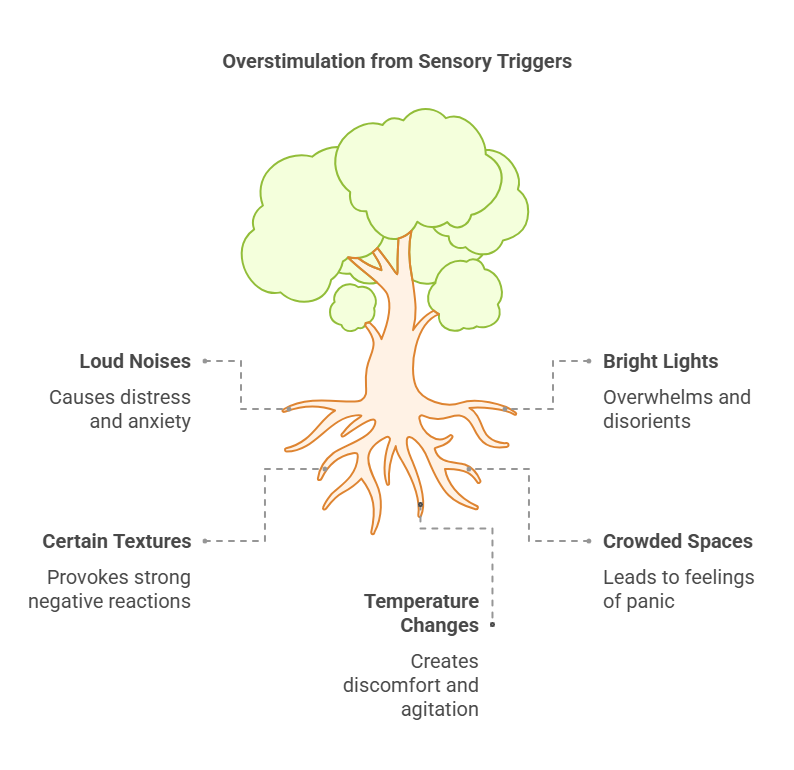Autism Spectrum Disorder (ASD) affects many children and teenagers worldwide, leading to unique challenges in behavior and communication. One of the most perplexing and often difficult-to-manage aspects of ASD is sudden anger triggers. Understanding these triggers and learning how to manage them is crucial for parents, caregivers, and educators. This blog post aims to provide comprehensive insights into the causes, signs, and management strategies for sudden anger in autistic individuals, primarily focusing on children and teenagers.

What Are Sudden Anger Triggers in Autism?
Sudden anger triggers in autistic individuals refer to specific stimuli or situations that cause a rapid onset of intense anger or frustration. These triggers can vary widely from person to person and can be difficult to predict. Unlike typical anger, which may build up gradually, these triggers can cause an immediate and intense emotional reaction.
Common misconceptions about anger in autism include the belief that autistic individuals are naturally more aggressive or violent. However, it is essential to understand that these outbursts are often a result of overwhelming sensory experiences, communication barriers, or changes in routine, rather than a desire to cause harm.
Understanding Sensory Sensitivity in Autism
Explanation of Sensory Processing Issues
Many autistic individuals experience sensory processing issues, which means their brains process sensory information differently. This can lead to heightened sensitivity to certain stimuli, such as loud noises, bright lights, or specific textures. For example, a seemingly harmless sound like a vacuum cleaner might be excruciatingly loud and painful for an autistic child.
Examples of Sensory Triggers
- Loud Noises: Fire alarms, sirens, or even a crowded cafeteria can cause distress.
- Bright Lights: Fluorescent lighting or sudden flashes of light can be overwhelming.
- Certain Textures: Some children may react strongly to the feel of certain fabrics or foods.
- Crowded Spaces: Being in a crowded room or public place can be overstimulating.
- Temperature Changes: Sudden shifts in temperature can also be a trigger.
 Ways to Identify Sensory Triggers
Ways to Identify Sensory Triggers
Identifying sensory triggers involves careful observation and sometimes keeping a sensory diary. Note the situations that lead to anger outbursts and look for patterns. For example, if a child consistently becomes upset in noisy environments, noise may be a significant trigger.
A sample sensory diary might look like this:
| Date | Trigger Situation | Child’s Reaction | Possible Sensory Trigger |
|---|---|---|---|
| 01/10/2023 | School cafeteria | Covered ears, screamed | Loud noises |
| 01/12/2023 | Shopping mall | Cried, wanted to leave | Crowded spaces, bright lights |
| 01/15/2023 | Wearing wool sweater | Pulled at sweater, cried | Texture of fabric |
| 01/17/2023 | Transition from indoors to outdoors | Screamed, kicked | Sudden temperature change |
Communication Barriers and Anger in Autism
Challenges in Expressing Needs and Emotions
Communication barriers are a significant source of frustration for many autistic individuals. These barriers can make it difficult for them to express their needs, emotions, or discomfort verbally. This can lead to feelings of helplessness and anger.
Non-Verbal Autistic Individuals and Frustration
For non-verbal autistic individuals, the frustration can be even greater. They may rely on other forms of communication, such as gestures or pictures, and when these methods fail, it can result in an anger outburst.
Tips to Improve Communication
- Use Visual Aids: Picture cards or communication boards can help non-verbal individuals express themselves.
- Teach Sign Language: Basic sign language can be a valuable tool for communication.
- Encourage Alternative Communication Methods: Apps and devices designed for communication can be helpful.
- Be Patient and Observant: Pay attention to non-verbal cues and be patient as the child attempts to communicate.
Jake, a 7-year-old boy with non-verbal autism, often experienced intense frustration when he couldn’t communicate his needs. His parents noticed that Jake frequently became upset during mealtimes but couldn’t express why. By introducing a picture exchange communication system (PECS), Jake could point to pictures of different foods to show what he wanted. This significantly reduced his frustration and anger outbursts during meals.
 Changes in Routine and Environmental Triggers
Changes in Routine and Environmental Triggers
Routine and predictability are essential for many autistic individuals. Changes in routine or environment can be highly distressing and can often trigger anger. Understanding this need for consistency is crucial in managing outbursts.
Common Scenarios Causing Distress
- Changes in Schedule: Unexpected changes in daily routines, such as a new teacher or a different route to school.
- New Environments: Moving to a new house, starting a new school, or even visiting a new place can be overwhelming.
- Social Situations: Unfamiliar social interactions or large gatherings can be challenging.
Strategies to Prepare for Changes
- Use Visual Schedules: Visual schedules can help prepare children for changes in routine.
- Provide Advance Notice: Whenever possible, give advance notice of any changes.
- Practice New Situations: Gradually introduce new environments or routines and practice them beforehand.
- Create a Safe Space: Ensure the child has a safe space to retreat to if they become overwhelmed.
Emily, a 13-year-old girl with autism, struggled with transitions and changes in her daily routine. Her parents implemented a visual schedule that outlined her day, including any changes that might occur. By reviewing the schedule each morning and discussing any upcoming changes, Emily felt more prepared and experienced fewer anger outbursts.
Managing Sudden Anger Triggers in Autistic Children and Teenagers
Self-Regulation Techniques for Anger Management
Self-regulation techniques can help autistic individuals manage their anger more effectively. Techniques such as deep breathing, counting to ten, or using a stress ball can be taught and practiced regularly.
Here are some self-regulation techniques that can be beneficial (check out the free anger management resource tool for more techniques):
- Deep Breathing: Teach the child to take slow, deep breaths to calm down.
- Counting to Ten: Encourage the child to count to ten slowly when feeling angry.
- Using a Stress Ball: Squeezing a stress ball can help release tension.
- Taking a Break: Allow the child to take a break and go to their safe space.
- Positive Self-Talk: Teach the child to use positive phrases like “I can handle this” or “It’s okay to feel angry.”
The Role of Therapy and Professional Help
Therapies such as Applied Behavior Analysis (ABA), Occupational Therapy (OT), and Speech Therapy can provide essential tools and strategies to help manage anger triggers. These therapies can be tailored to the individual needs of the child and can address specific triggers and behaviors.
- Applied Behavior Analysis (ABA): Focuses on improving specific behaviors, such as social skills, communication, and learning skills.
- Occupational Therapy (OT): Helps children develop the skills needed for daily living and coping with sensory issues.
- Speech Therapy: Assists in improving communication skills, both verbal and non-verbal.
Creating a Supportive Environment for Autism Awareness and Anger Management
Having a designated safe space where the child can retreat when feeling overwhelmed can be incredibly helpful. This space should be quiet, comfortable, and free of sensory triggers.
 Building a Support Network
Building a Support Network
A strong support network of family, friends, and professionals can provide the necessary support and resources to manage anger triggers. Joining support groups and connecting with other parents can also be invaluable.
Sarah, a 10-year-old girl with autism, often experienced sudden anger outbursts due to sensory overload. Her parents noticed that loud noises, such as the school bell, were significant triggers. By working with her teachers, they implemented noise-canceling headphones and created a quiet corner in her classroom. Additionally, Sarah’s parents used a visual schedule to help her anticipate changes in her routine. Over time, these strategies helped Sarah manage her anger more effectively, leading to fewer outbursts and a more positive school experience.
Conclusion
Understanding and managing sudden anger triggers in autistic children and teenagers is a multifaceted challenge that requires patience, observation, and a supportive environment. By identifying specific triggers, improving communication, and creating consistent routines, parents and caregivers can significantly reduce the frequency and intensity of anger outbursts. Remember, every child is unique, and what works for one may not work for another. Continuous learning, adaptation, and support are key to helping autistic individuals thrive.
For more resources and support, consider visiting the following websites:
Remember, managing sudden anger triggers is a journey that requires ongoing effort and understanding. With the right strategies, support, and a nurturing environment, autistic children and teenagers can learn to navigate their emotions more effectively and lead fulfilling lives.

 Ways to Identify Sensory Triggers
Ways to Identify Sensory Triggers Changes in Routine and Environmental Triggers
Changes in Routine and Environmental Triggers Building a Support Network
Building a Support Network
